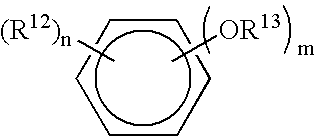Antiseptic compositions and methods of use
- Summary
- Abstract
- Description
- Claims
- Application Information
AI Technical Summary
Benefits of technology
Problems solved by technology
Method used
Image
Examples
example 1
[0256] An antimicrobial composition of 250 grams was prepared using the components shown in table 2a. Carbowax 1450 PEG was melted in an oven at approximately 70° C. in a glass container. Glycerin and Carbowax 400 were added to the container and swirled by hand to mix and then heated again to 70° C. The remaining components (lauric acid, lactic acid, Complemix DOSS) were added to the container and mixed using a high shear rotor / stator Silverson homogenizer on high speed for 1 minute. The composition was allowed to cool on rollers to approximately 40° C. then transferred into jars, and sealed.
examples 2-3
[0257] Antimicrobial compositions of 250 grams were prepared using the components shown in table 2a. Tea tree oil and Complemix DOSS were added to glycerin in a glass container and heated to 70° C. in an oven. Carbowax 400 and Carbowax 1450 were added to the beaker, swirled by hand to mix and reheated to 70° C. in the oven. The composition was removed from the oven allowed to cool to approximately 40° C., while mixing on rollers, then transferred into jars and sealed.
[0258] Examples 1-3 show that increasing the concentrations of Tea Tree oil or addition of an anionic surfactant improve the antimicrobial efficacy to achieve complete kill in 10 minutes against E. coli and near complete kill against MRSA in only 2.5 minutes.
example 4
[0259] An antimicrobial composition of 250 grams was prepared in the same manner as examples 2-3, using the components shown in table 2a, except that lauric acid was used as the antimicrobial component instead of tea tree oil.
[0260] Example 4 shows that an alkyl carboxylic acid in a hydrophilic vehicle is capable of achieving complete kill against both MRSA and E. coli in 2.5 minutes or less.
PUM
| Property | Measurement | Unit |
|---|---|---|
| Temperature | aaaaa | aaaaa |
| Fraction | aaaaa | aaaaa |
| Time | aaaaa | aaaaa |
Abstract
Description
Claims
Application Information
 Login to View More
Login to View More - R&D
- Intellectual Property
- Life Sciences
- Materials
- Tech Scout
- Unparalleled Data Quality
- Higher Quality Content
- 60% Fewer Hallucinations
Browse by: Latest US Patents, China's latest patents, Technical Efficacy Thesaurus, Application Domain, Technology Topic, Popular Technical Reports.
© 2025 PatSnap. All rights reserved.Legal|Privacy policy|Modern Slavery Act Transparency Statement|Sitemap|About US| Contact US: help@patsnap.com


